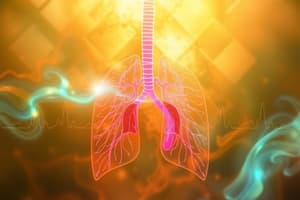Podcast
Questions and Answers
Which acid-base imbalance would the nurse expect to assess in a client who is fasting and has ketones in the urine?
Which acid-base imbalance would the nurse expect to assess in a client who is fasting and has ketones in the urine?
- Respiratory alkalosis
- Metabolic alkalosis
- Respiratory acidosis
- Metabolic acidosis (correct)
How would the nurse interpret a child with acute asthma who has a PaCO2 of 48 mmHg, a pH of 7.31, and normal HCO3?
How would the nurse interpret a child with acute asthma who has a PaCO2 of 48 mmHg, a pH of 7.31, and normal HCO3?
- Metabolic acidosis
- Metabolic alkalosis
- Respiratory alkalosis
- Respiratory acidosis (correct)
Which of the following risk factors would place a client at risk for metabolic acidosis? (Select all that apply)
Which of the following risk factors would place a client at risk for metabolic acidosis? (Select all that apply)
- Pneumonia
- Abdominal fistulas (correct)
- Acute renal failure (correct)
- Chronic obstructive pulmonary disease
- Hypovolemic shock (correct)
Which test will provide the most accurate indicator of the client's acid-base balance?
Which test will provide the most accurate indicator of the client's acid-base balance?
Which nursing action would be appropriate for a client in diabetic ketoacidosis who practices fasting?
Which nursing action would be appropriate for a client in diabetic ketoacidosis who practices fasting?
Which client statement indicates that additional teaching is needed regarding the use of sodium bicarbonate?
Which client statement indicates that additional teaching is needed regarding the use of sodium bicarbonate?
Flashcards are hidden until you start studying
Study Notes
Acid-Base Imbalances
- A client who has been fasting is at risk for developing metabolic acidosis, as the body metabolizes proteins into ketones (metabolic acids) during starvation.
- Metabolic acidosis is not usually a primary disorder, but develops during other diseases such as acute renal failure or hypovolemic shock. It can also be caused by abdominal fistulas, which lead to excessive bicarbonate loss.
- Chronic obstructive pulmonary disease and pneumonia increase risk of respiratory acidosis due to carbon dioxide retention.
- A child with acute asthma experiencing respiratory acidosis will have a decreased pH (acidic), increased PaCO2 (carbon dioxide), and a normal HCO3 (bicarbonate).
- Arterial blood gases (ABGs) are the most accurate indicator of acid-base balance in clients with respiratory disorders, metabolic disorders, or both.
- Clients with a history of acidosis should contact their doctor immediately if they experience gastric discomfort accompanied by chest pain, dyspnea, or diaphoresis while using sodium bicarbonate antacids. They should also avoid using sodium bicarbonate antacids for more than two weeks and use non-sodium antacids to prevent excess sodium or bicarbonate absorption.
- Clients with diabetes mellitus should be advised to seek medical care immediately if signs of ketoacidosis occur.
- A nurse should consult with a diabetes educator and assess the client's religious beliefs in order to provide guidance for fasting safely.
Studying That Suits You
Use AI to generate personalized quizzes and flashcards to suit your learning preferences.





